Analysis of Contracts and Procurement for the Royal Adelaide Hospital
VerifiedAdded on 2023/06/04
|11
|2664
|459
Report
AI Summary
This report provides a comprehensive analysis of the New Royal Adelaide Hospital (RAH) project, focusing on contracts, procurement, and project management. The project, a significant undertaking in South Australia, involved a Public-Private Partnership (PPP) model, which led to various challenges including delays, cost overruns, and risk management issues. The report examines the project's governance structure, risk allocation, and the roles of key stakeholders such as the Executive Director, Steering Committee, Program Director, and Project Director. It highlights the complexities of implementing ICT systems, managing contractual obligations, and addressing contamination risks. The analysis delves into the impact of delays, financial implications, and the importance of effective risk management strategies, including identifying, implementing, and monitoring risk mitigation plans. The report also explores the significance of project planning, procurement management, and the need for a strong business case to ensure successful project delivery and stakeholder satisfaction. The report concludes by emphasizing the importance of effective governance, clear communication, and proactive risk management to achieve desired project outcomes and deliver improved health services to the community.
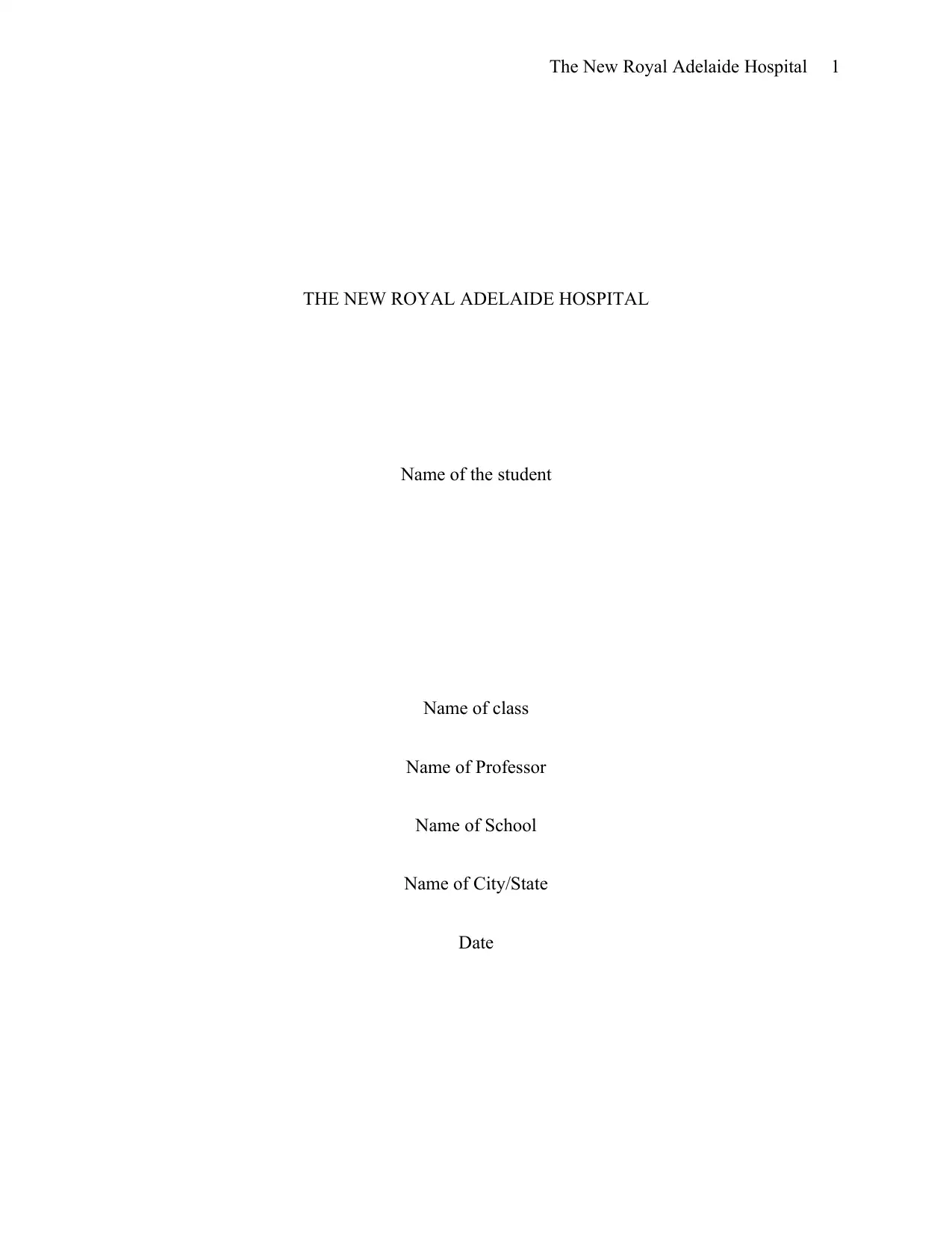
The New Royal Adelaide Hospital 1
THE NEW ROYAL ADELAIDE HOSPITAL
Name of the student
Name of class
Name of Professor
Name of School
Name of City/State
Date
THE NEW ROYAL ADELAIDE HOSPITAL
Name of the student
Name of class
Name of Professor
Name of School
Name of City/State
Date
Paraphrase This Document
Need a fresh take? Get an instant paraphrase of this document with our AI Paraphraser
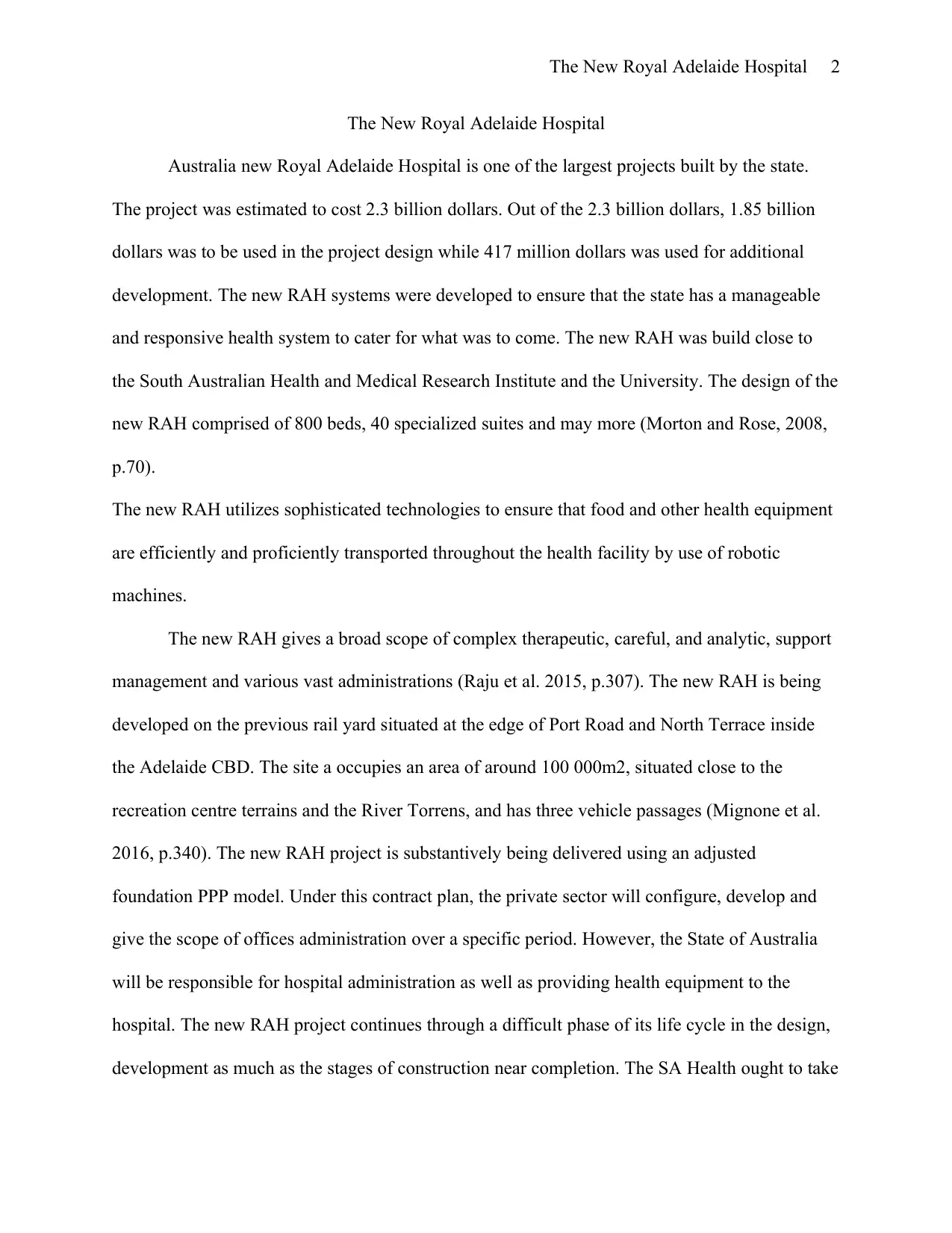
The New Royal Adelaide Hospital 2
The New Royal Adelaide Hospital
Australia new Royal Adelaide Hospital is one of the largest projects built by the state.
The project was estimated to cost 2.3 billion dollars. Out of the 2.3 billion dollars, 1.85 billion
dollars was to be used in the project design while 417 million dollars was used for additional
development. The new RAH systems were developed to ensure that the state has a manageable
and responsive health system to cater for what was to come. The new RAH was build close to
the South Australian Health and Medical Research Institute and the University. The design of the
new RAH comprised of 800 beds, 40 specialized suites and may more (Morton and Rose, 2008,
p.70).
The new RAH utilizes sophisticated technologies to ensure that food and other health equipment
are efficiently and proficiently transported throughout the health facility by use of robotic
machines.
The new RAH gives a broad scope of complex therapeutic, careful, and analytic, support
management and various vast administrations (Raju et al. 2015, p.307). The new RAH is being
developed on the previous rail yard situated at the edge of Port Road and North Terrace inside
the Adelaide CBD. The site a occupies an area of around 100 000m2, situated close to the
recreation centre terrains and the River Torrens, and has three vehicle passages (Mignone et al.
2016, p.340). The new RAH project is substantively being delivered using an adjusted
foundation PPP model. Under this contract plan, the private sector will configure, develop and
give the scope of offices administration over a specific period. However, the State of Australia
will be responsible for hospital administration as well as providing health equipment to the
hospital. The new RAH project continues through a difficult phase of its life cycle in the design,
development as much as the stages of construction near completion. The SA Health ought to take
The New Royal Adelaide Hospital
Australia new Royal Adelaide Hospital is one of the largest projects built by the state.
The project was estimated to cost 2.3 billion dollars. Out of the 2.3 billion dollars, 1.85 billion
dollars was to be used in the project design while 417 million dollars was used for additional
development. The new RAH systems were developed to ensure that the state has a manageable
and responsive health system to cater for what was to come. The new RAH was build close to
the South Australian Health and Medical Research Institute and the University. The design of the
new RAH comprised of 800 beds, 40 specialized suites and may more (Morton and Rose, 2008,
p.70).
The new RAH utilizes sophisticated technologies to ensure that food and other health equipment
are efficiently and proficiently transported throughout the health facility by use of robotic
machines.
The new RAH gives a broad scope of complex therapeutic, careful, and analytic, support
management and various vast administrations (Raju et al. 2015, p.307). The new RAH is being
developed on the previous rail yard situated at the edge of Port Road and North Terrace inside
the Adelaide CBD. The site a occupies an area of around 100 000m2, situated close to the
recreation centre terrains and the River Torrens, and has three vehicle passages (Mignone et al.
2016, p.340). The new RAH project is substantively being delivered using an adjusted
foundation PPP model. Under this contract plan, the private sector will configure, develop and
give the scope of offices administration over a specific period. However, the State of Australia
will be responsible for hospital administration as well as providing health equipment to the
hospital. The new RAH project continues through a difficult phase of its life cycle in the design,
development as much as the stages of construction near completion. The SA Health ought to take
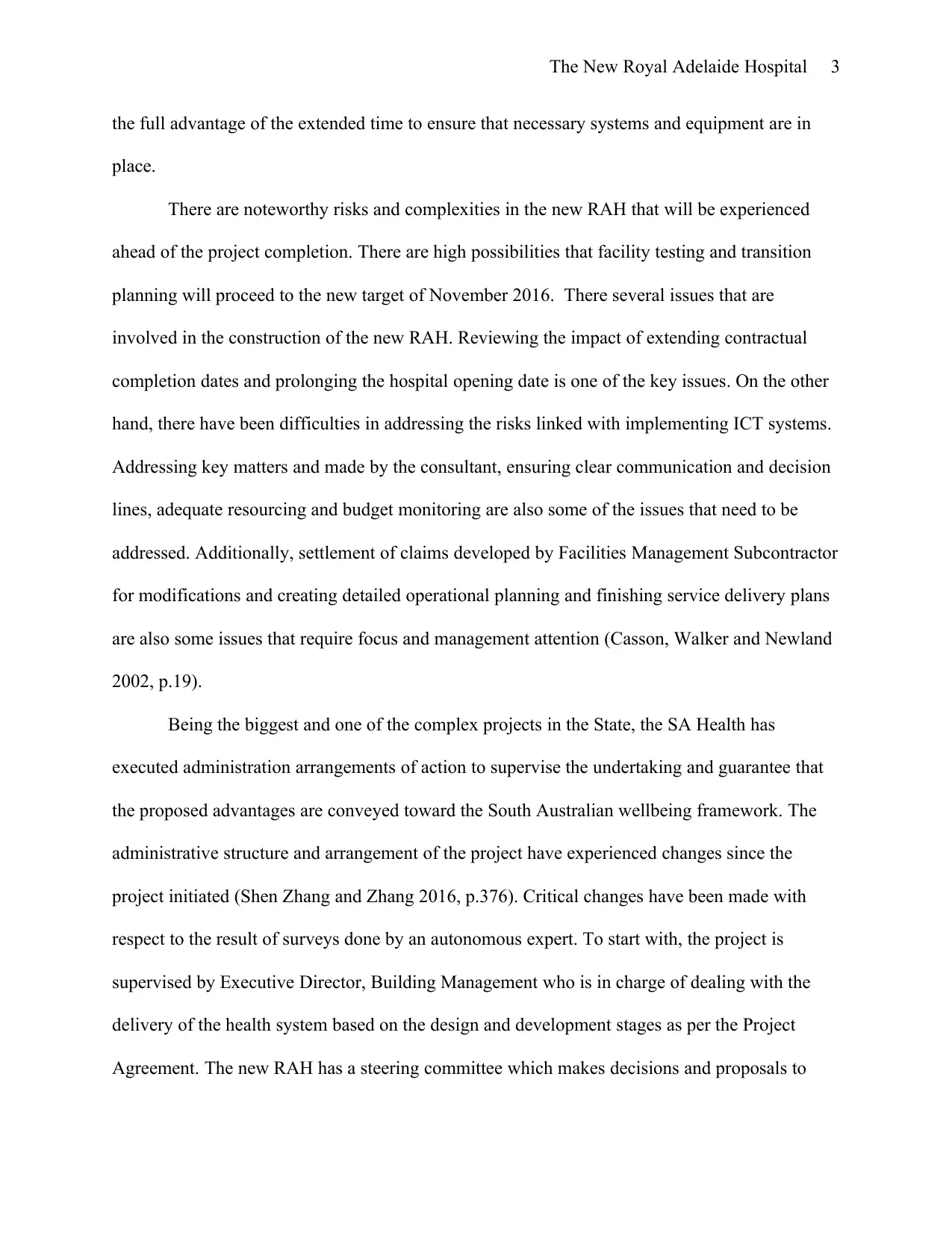
The New Royal Adelaide Hospital 3
the full advantage of the extended time to ensure that necessary systems and equipment are in
place.
There are noteworthy risks and complexities in the new RAH that will be experienced
ahead of the project completion. There are high possibilities that facility testing and transition
planning will proceed to the new target of November 2016. There several issues that are
involved in the construction of the new RAH. Reviewing the impact of extending contractual
completion dates and prolonging the hospital opening date is one of the key issues. On the other
hand, there have been difficulties in addressing the risks linked with implementing ICT systems.
Addressing key matters and made by the consultant, ensuring clear communication and decision
lines, adequate resourcing and budget monitoring are also some of the issues that need to be
addressed. Additionally, settlement of claims developed by Facilities Management Subcontractor
for modifications and creating detailed operational planning and finishing service delivery plans
are also some issues that require focus and management attention (Casson, Walker and Newland
2002, p.19).
Being the biggest and one of the complex projects in the State, the SA Health has
executed administration arrangements of action to supervise the undertaking and guarantee that
the proposed advantages are conveyed toward the South Australian wellbeing framework. The
administrative structure and arrangement of the project have experienced changes since the
project initiated (Shen Zhang and Zhang 2016, p.376). Critical changes have been made with
respect to the result of surveys done by an autonomous expert. To start with, the project is
supervised by Executive Director, Building Management who is in charge of dealing with the
delivery of the health system based on the design and development stages as per the Project
Agreement. The new RAH has a steering committee which makes decisions and proposals to
the full advantage of the extended time to ensure that necessary systems and equipment are in
place.
There are noteworthy risks and complexities in the new RAH that will be experienced
ahead of the project completion. There are high possibilities that facility testing and transition
planning will proceed to the new target of November 2016. There several issues that are
involved in the construction of the new RAH. Reviewing the impact of extending contractual
completion dates and prolonging the hospital opening date is one of the key issues. On the other
hand, there have been difficulties in addressing the risks linked with implementing ICT systems.
Addressing key matters and made by the consultant, ensuring clear communication and decision
lines, adequate resourcing and budget monitoring are also some of the issues that need to be
addressed. Additionally, settlement of claims developed by Facilities Management Subcontractor
for modifications and creating detailed operational planning and finishing service delivery plans
are also some issues that require focus and management attention (Casson, Walker and Newland
2002, p.19).
Being the biggest and one of the complex projects in the State, the SA Health has
executed administration arrangements of action to supervise the undertaking and guarantee that
the proposed advantages are conveyed toward the South Australian wellbeing framework. The
administrative structure and arrangement of the project have experienced changes since the
project initiated (Shen Zhang and Zhang 2016, p.376). Critical changes have been made with
respect to the result of surveys done by an autonomous expert. To start with, the project is
supervised by Executive Director, Building Management who is in charge of dealing with the
delivery of the health system based on the design and development stages as per the Project
Agreement. The new RAH has a steering committee which makes decisions and proposals to
⊘ This is a preview!⊘
Do you want full access?
Subscribe today to unlock all pages.

Trusted by 1+ million students worldwide
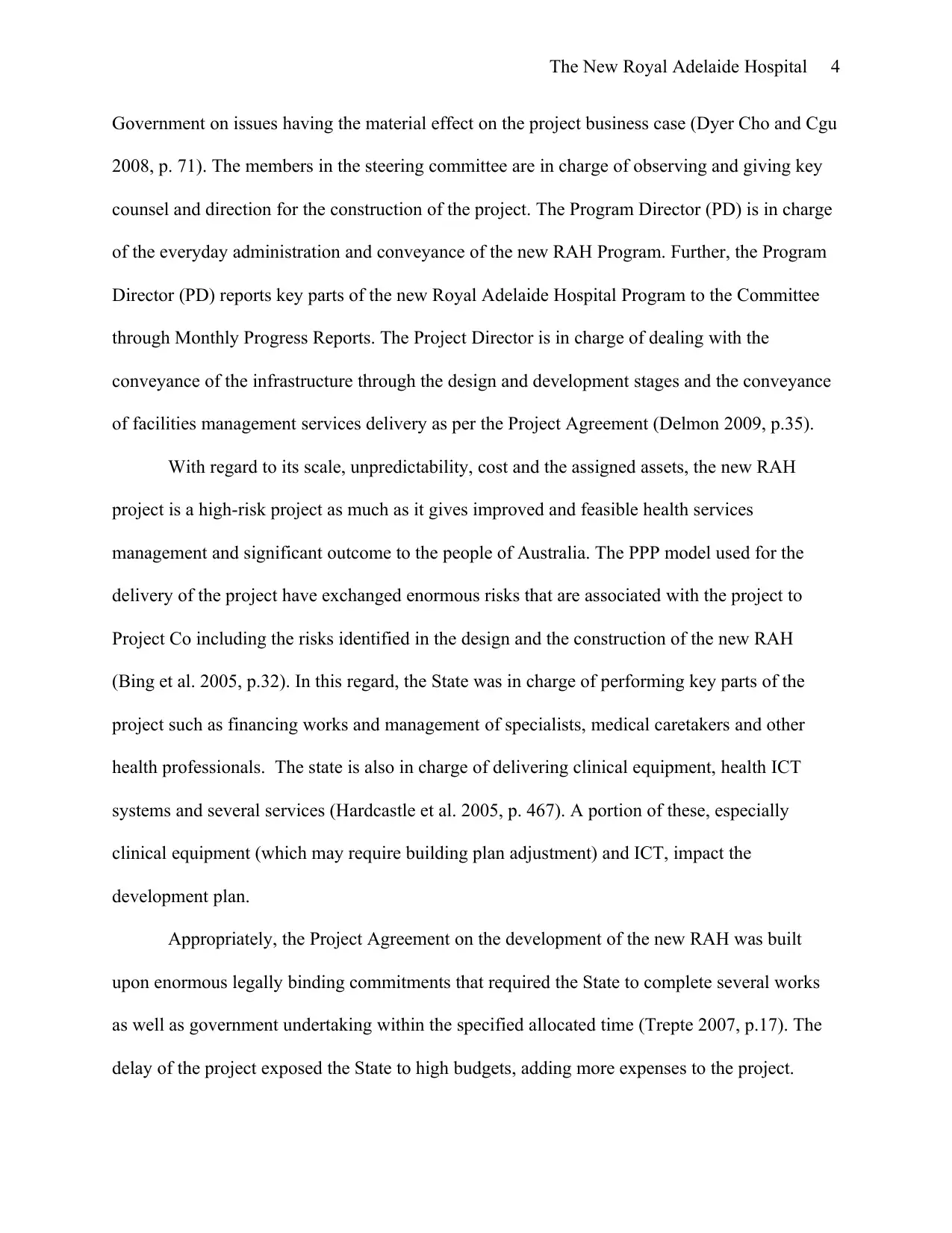
The New Royal Adelaide Hospital 4
Government on issues having the material effect on the project business case (Dyer Cho and Cgu
2008, p. 71). The members in the steering committee are in charge of observing and giving key
counsel and direction for the construction of the project. The Program Director (PD) is in charge
of the everyday administration and conveyance of the new RAH Program. Further, the Program
Director (PD) reports key parts of the new Royal Adelaide Hospital Program to the Committee
through Monthly Progress Reports. The Project Director is in charge of dealing with the
conveyance of the infrastructure through the design and development stages and the conveyance
of facilities management services delivery as per the Project Agreement (Delmon 2009, p.35).
With regard to its scale, unpredictability, cost and the assigned assets, the new RAH
project is a high-risk project as much as it gives improved and feasible health services
management and significant outcome to the people of Australia. The PPP model used for the
delivery of the project have exchanged enormous risks that are associated with the project to
Project Co including the risks identified in the design and the construction of the new RAH
(Bing et al. 2005, p.32). In this regard, the State was in charge of performing key parts of the
project such as financing works and management of specialists, medical caretakers and other
health professionals. The state is also in charge of delivering clinical equipment, health ICT
systems and several services (Hardcastle et al. 2005, p. 467). A portion of these, especially
clinical equipment (which may require building plan adjustment) and ICT, impact the
development plan.
Appropriately, the Project Agreement on the development of the new RAH was built
upon enormous legally binding commitments that required the State to complete several works
as well as government undertaking within the specified allocated time (Trepte 2007, p.17). The
delay of the project exposed the State to high budgets, adding more expenses to the project.
Government on issues having the material effect on the project business case (Dyer Cho and Cgu
2008, p. 71). The members in the steering committee are in charge of observing and giving key
counsel and direction for the construction of the project. The Program Director (PD) is in charge
of the everyday administration and conveyance of the new RAH Program. Further, the Program
Director (PD) reports key parts of the new Royal Adelaide Hospital Program to the Committee
through Monthly Progress Reports. The Project Director is in charge of dealing with the
conveyance of the infrastructure through the design and development stages and the conveyance
of facilities management services delivery as per the Project Agreement (Delmon 2009, p.35).
With regard to its scale, unpredictability, cost and the assigned assets, the new RAH
project is a high-risk project as much as it gives improved and feasible health services
management and significant outcome to the people of Australia. The PPP model used for the
delivery of the project have exchanged enormous risks that are associated with the project to
Project Co including the risks identified in the design and the construction of the new RAH
(Bing et al. 2005, p.32). In this regard, the State was in charge of performing key parts of the
project such as financing works and management of specialists, medical caretakers and other
health professionals. The state is also in charge of delivering clinical equipment, health ICT
systems and several services (Hardcastle et al. 2005, p. 467). A portion of these, especially
clinical equipment (which may require building plan adjustment) and ICT, impact the
development plan.
Appropriately, the Project Agreement on the development of the new RAH was built
upon enormous legally binding commitments that required the State to complete several works
as well as government undertaking within the specified allocated time (Trepte 2007, p.17). The
delay of the project exposed the State to high budgets, adding more expenses to the project.
Paraphrase This Document
Need a fresh take? Get an instant paraphrase of this document with our AI Paraphraser
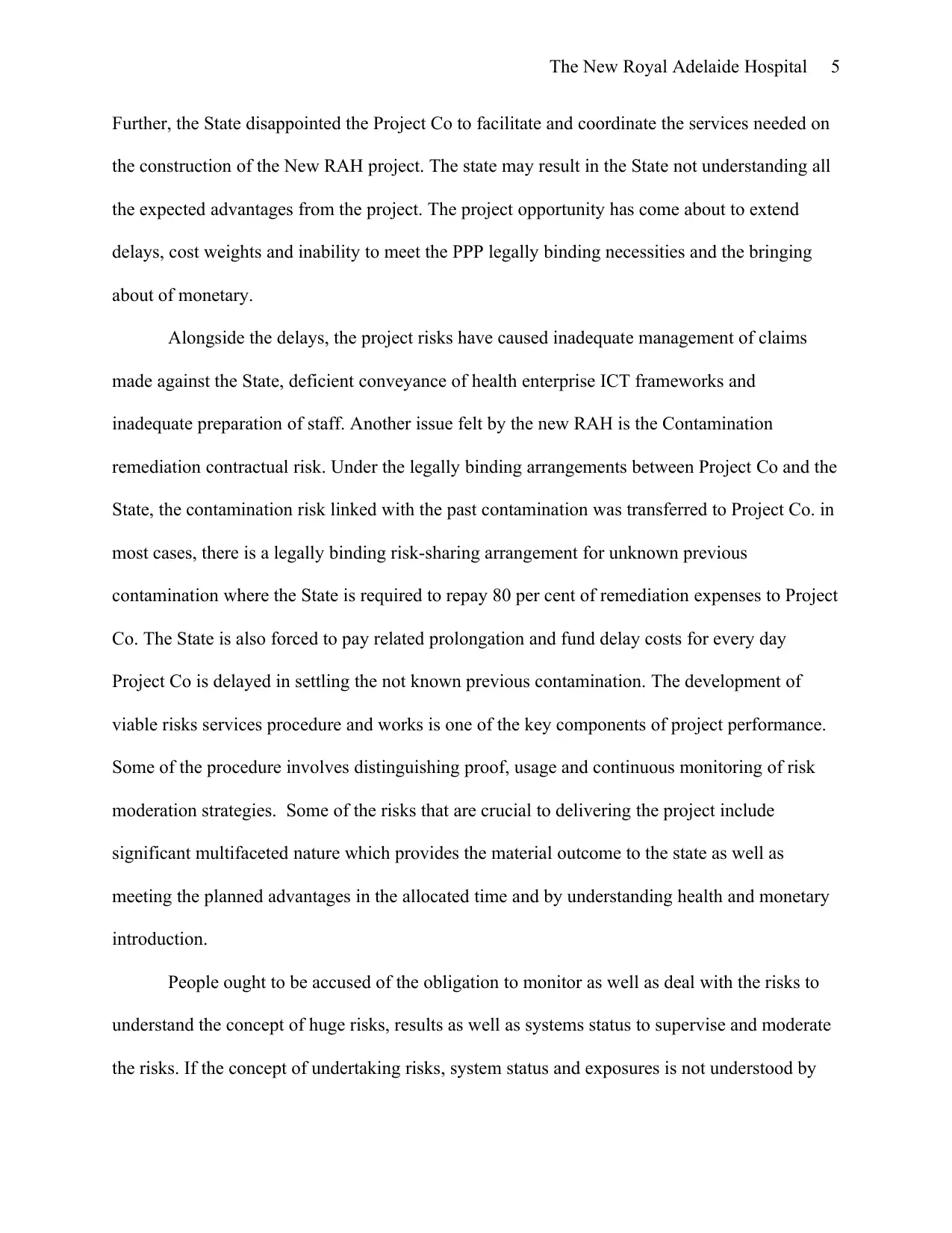
The New Royal Adelaide Hospital 5
Further, the State disappointed the Project Co to facilitate and coordinate the services needed on
the construction of the New RAH project. The state may result in the State not understanding all
the expected advantages from the project. The project opportunity has come about to extend
delays, cost weights and inability to meet the PPP legally binding necessities and the bringing
about of monetary.
Alongside the delays, the project risks have caused inadequate management of claims
made against the State, deficient conveyance of health enterprise ICT frameworks and
inadequate preparation of staff. Another issue felt by the new RAH is the Contamination
remediation contractual risk. Under the legally binding arrangements between Project Co and the
State, the contamination risk linked with the past contamination was transferred to Project Co. in
most cases, there is a legally binding risk-sharing arrangement for unknown previous
contamination where the State is required to repay 80 per cent of remediation expenses to Project
Co. The State is also forced to pay related prolongation and fund delay costs for every day
Project Co is delayed in settling the not known previous contamination. The development of
viable risks services procedure and works is one of the key components of project performance.
Some of the procedure involves distinguishing proof, usage and continuous monitoring of risk
moderation strategies. Some of the risks that are crucial to delivering the project include
significant multifaceted nature which provides the material outcome to the state as well as
meeting the planned advantages in the allocated time and by understanding health and monetary
introduction.
People ought to be accused of the obligation to monitor as well as deal with the risks to
understand the concept of huge risks, results as well as systems status to supervise and moderate
the risks. If the concept of undertaking risks, system status and exposures is not understood by
Further, the State disappointed the Project Co to facilitate and coordinate the services needed on
the construction of the New RAH project. The state may result in the State not understanding all
the expected advantages from the project. The project opportunity has come about to extend
delays, cost weights and inability to meet the PPP legally binding necessities and the bringing
about of monetary.
Alongside the delays, the project risks have caused inadequate management of claims
made against the State, deficient conveyance of health enterprise ICT frameworks and
inadequate preparation of staff. Another issue felt by the new RAH is the Contamination
remediation contractual risk. Under the legally binding arrangements between Project Co and the
State, the contamination risk linked with the past contamination was transferred to Project Co. in
most cases, there is a legally binding risk-sharing arrangement for unknown previous
contamination where the State is required to repay 80 per cent of remediation expenses to Project
Co. The State is also forced to pay related prolongation and fund delay costs for every day
Project Co is delayed in settling the not known previous contamination. The development of
viable risks services procedure and works is one of the key components of project performance.
Some of the procedure involves distinguishing proof, usage and continuous monitoring of risk
moderation strategies. Some of the risks that are crucial to delivering the project include
significant multifaceted nature which provides the material outcome to the state as well as
meeting the planned advantages in the allocated time and by understanding health and monetary
introduction.
People ought to be accused of the obligation to monitor as well as deal with the risks to
understand the concept of huge risks, results as well as systems status to supervise and moderate
the risks. If the concept of undertaking risks, system status and exposures is not understood by
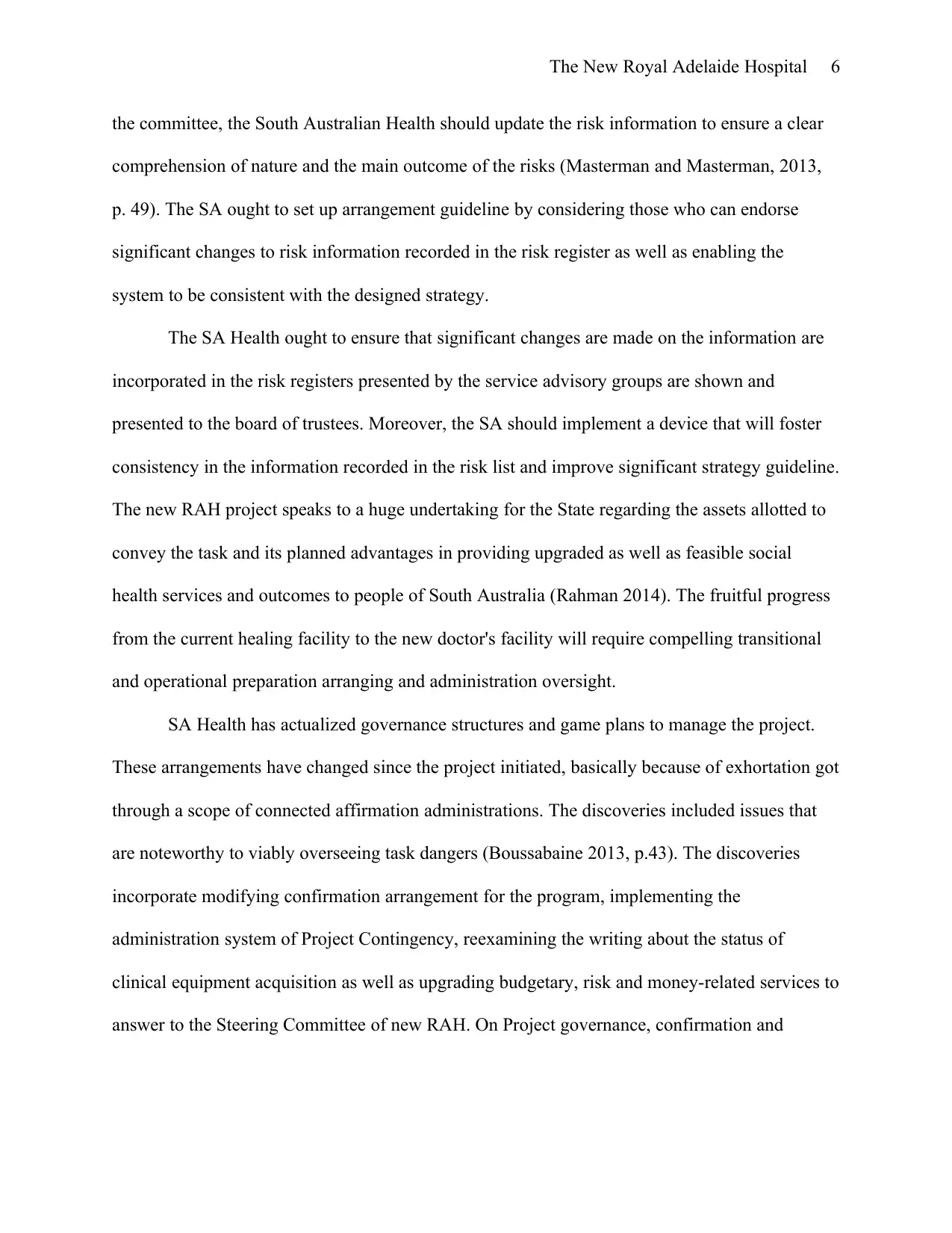
The New Royal Adelaide Hospital 6
the committee, the South Australian Health should update the risk information to ensure a clear
comprehension of nature and the main outcome of the risks (Masterman and Masterman, 2013,
p. 49). The SA ought to set up arrangement guideline by considering those who can endorse
significant changes to risk information recorded in the risk register as well as enabling the
system to be consistent with the designed strategy.
The SA Health ought to ensure that significant changes are made on the information are
incorporated in the risk registers presented by the service advisory groups are shown and
presented to the board of trustees. Moreover, the SA should implement a device that will foster
consistency in the information recorded in the risk list and improve significant strategy guideline.
The new RAH project speaks to a huge undertaking for the State regarding the assets allotted to
convey the task and its planned advantages in providing upgraded as well as feasible social
health services and outcomes to people of South Australia (Rahman 2014). The fruitful progress
from the current healing facility to the new doctor's facility will require compelling transitional
and operational preparation arranging and administration oversight.
SA Health has actualized governance structures and game plans to manage the project.
These arrangements have changed since the project initiated, basically because of exhortation got
through a scope of connected affirmation administrations. The discoveries included issues that
are noteworthy to viably overseeing task dangers (Boussabaine 2013, p.43). The discoveries
incorporate modifying confirmation arrangement for the program, implementing the
administration system of Project Contingency, reexamining the writing about the status of
clinical equipment acquisition as well as upgrading budgetary, risk and money-related services to
answer to the Steering Committee of new RAH. On Project governance, confirmation and
the committee, the South Australian Health should update the risk information to ensure a clear
comprehension of nature and the main outcome of the risks (Masterman and Masterman, 2013,
p. 49). The SA ought to set up arrangement guideline by considering those who can endorse
significant changes to risk information recorded in the risk register as well as enabling the
system to be consistent with the designed strategy.
The SA Health ought to ensure that significant changes are made on the information are
incorporated in the risk registers presented by the service advisory groups are shown and
presented to the board of trustees. Moreover, the SA should implement a device that will foster
consistency in the information recorded in the risk list and improve significant strategy guideline.
The new RAH project speaks to a huge undertaking for the State regarding the assets allotted to
convey the task and its planned advantages in providing upgraded as well as feasible social
health services and outcomes to people of South Australia (Rahman 2014). The fruitful progress
from the current healing facility to the new doctor's facility will require compelling transitional
and operational preparation arranging and administration oversight.
SA Health has actualized governance structures and game plans to manage the project.
These arrangements have changed since the project initiated, basically because of exhortation got
through a scope of connected affirmation administrations. The discoveries included issues that
are noteworthy to viably overseeing task dangers (Boussabaine 2013, p.43). The discoveries
incorporate modifying confirmation arrangement for the program, implementing the
administration system of Project Contingency, reexamining the writing about the status of
clinical equipment acquisition as well as upgrading budgetary, risk and money-related services to
answer to the Steering Committee of new RAH. On Project governance, confirmation and
⊘ This is a preview!⊘
Do you want full access?
Subscribe today to unlock all pages.

Trusted by 1+ million students worldwide
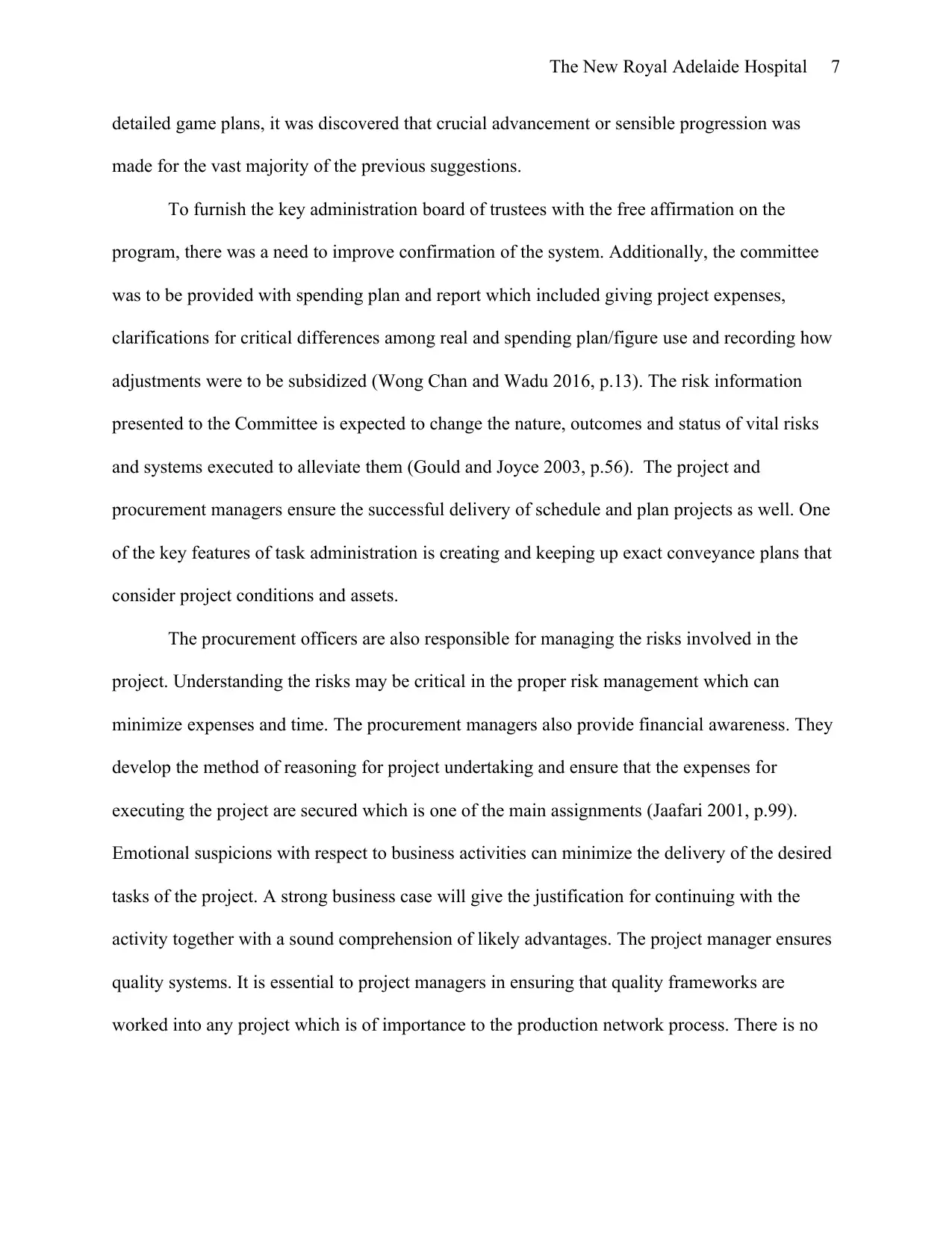
The New Royal Adelaide Hospital 7
detailed game plans, it was discovered that crucial advancement or sensible progression was
made for the vast majority of the previous suggestions.
To furnish the key administration board of trustees with the free affirmation on the
program, there was a need to improve confirmation of the system. Additionally, the committee
was to be provided with spending plan and report which included giving project expenses,
clarifications for critical differences among real and spending plan/figure use and recording how
adjustments were to be subsidized (Wong Chan and Wadu 2016, p.13). The risk information
presented to the Committee is expected to change the nature, outcomes and status of vital risks
and systems executed to alleviate them (Gould and Joyce 2003, p.56). The project and
procurement managers ensure the successful delivery of schedule and plan projects as well. One
of the key features of task administration is creating and keeping up exact conveyance plans that
consider project conditions and assets.
The procurement officers are also responsible for managing the risks involved in the
project. Understanding the risks may be critical in the proper risk management which can
minimize expenses and time. The procurement managers also provide financial awareness. They
develop the method of reasoning for project undertaking and ensure that the expenses for
executing the project are secured which is one of the main assignments (Jaafari 2001, p.99).
Emotional suspicions with respect to business activities can minimize the delivery of the desired
tasks of the project. A strong business case will give the justification for continuing with the
activity together with a sound comprehension of likely advantages. The project manager ensures
quality systems. It is essential to project managers in ensuring that quality frameworks are
worked into any project which is of importance to the production network process. There is no
detailed game plans, it was discovered that crucial advancement or sensible progression was
made for the vast majority of the previous suggestions.
To furnish the key administration board of trustees with the free affirmation on the
program, there was a need to improve confirmation of the system. Additionally, the committee
was to be provided with spending plan and report which included giving project expenses,
clarifications for critical differences among real and spending plan/figure use and recording how
adjustments were to be subsidized (Wong Chan and Wadu 2016, p.13). The risk information
presented to the Committee is expected to change the nature, outcomes and status of vital risks
and systems executed to alleviate them (Gould and Joyce 2003, p.56). The project and
procurement managers ensure the successful delivery of schedule and plan projects as well. One
of the key features of task administration is creating and keeping up exact conveyance plans that
consider project conditions and assets.
The procurement officers are also responsible for managing the risks involved in the
project. Understanding the risks may be critical in the proper risk management which can
minimize expenses and time. The procurement managers also provide financial awareness. They
develop the method of reasoning for project undertaking and ensure that the expenses for
executing the project are secured which is one of the main assignments (Jaafari 2001, p.99).
Emotional suspicions with respect to business activities can minimize the delivery of the desired
tasks of the project. A strong business case will give the justification for continuing with the
activity together with a sound comprehension of likely advantages. The project manager ensures
quality systems. It is essential to project managers in ensuring that quality frameworks are
worked into any project which is of importance to the production network process. There is no
Paraphrase This Document
Need a fresh take? Get an instant paraphrase of this document with our AI Paraphraser

The New Royal Adelaide Hospital 8
reason for anchoring merchandise in a key way with low expenses, in case they are not fit to
address the business issue
reason for anchoring merchandise in a key way with low expenses, in case they are not fit to
address the business issue
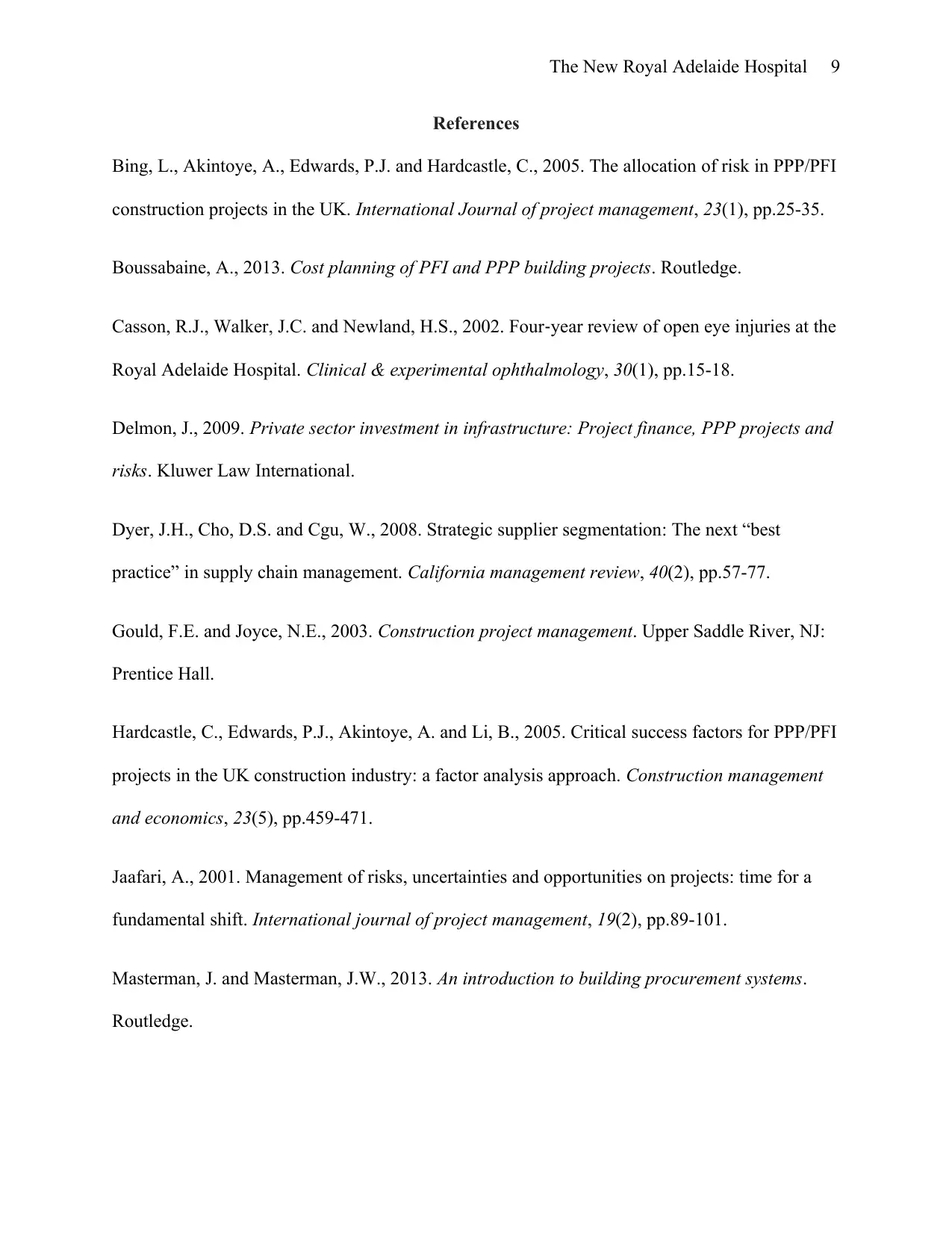
The New Royal Adelaide Hospital 9
References
Bing, L., Akintoye, A., Edwards, P.J. and Hardcastle, C., 2005. The allocation of risk in PPP/PFI
construction projects in the UK. International Journal of project management, 23(1), pp.25-35.
Boussabaine, A., 2013. Cost planning of PFI and PPP building projects. Routledge.
Casson, R.J., Walker, J.C. and Newland, H.S., 2002. Four‐year review of open eye injuries at the
Royal Adelaide Hospital. Clinical & experimental ophthalmology, 30(1), pp.15-18.
Delmon, J., 2009. Private sector investment in infrastructure: Project finance, PPP projects and
risks. Kluwer Law International.
Dyer, J.H., Cho, D.S. and Cgu, W., 2008. Strategic supplier segmentation: The next “best
practice” in supply chain management. California management review, 40(2), pp.57-77.
Gould, F.E. and Joyce, N.E., 2003. Construction project management. Upper Saddle River, NJ:
Prentice Hall.
Hardcastle, C., Edwards, P.J., Akintoye, A. and Li, B., 2005. Critical success factors for PPP/PFI
projects in the UK construction industry: a factor analysis approach. Construction management
and economics, 23(5), pp.459-471.
Jaafari, A., 2001. Management of risks, uncertainties and opportunities on projects: time for a
fundamental shift. International journal of project management, 19(2), pp.89-101.
Masterman, J. and Masterman, J.W., 2013. An introduction to building procurement systems.
Routledge.
References
Bing, L., Akintoye, A., Edwards, P.J. and Hardcastle, C., 2005. The allocation of risk in PPP/PFI
construction projects in the UK. International Journal of project management, 23(1), pp.25-35.
Boussabaine, A., 2013. Cost planning of PFI and PPP building projects. Routledge.
Casson, R.J., Walker, J.C. and Newland, H.S., 2002. Four‐year review of open eye injuries at the
Royal Adelaide Hospital. Clinical & experimental ophthalmology, 30(1), pp.15-18.
Delmon, J., 2009. Private sector investment in infrastructure: Project finance, PPP projects and
risks. Kluwer Law International.
Dyer, J.H., Cho, D.S. and Cgu, W., 2008. Strategic supplier segmentation: The next “best
practice” in supply chain management. California management review, 40(2), pp.57-77.
Gould, F.E. and Joyce, N.E., 2003. Construction project management. Upper Saddle River, NJ:
Prentice Hall.
Hardcastle, C., Edwards, P.J., Akintoye, A. and Li, B., 2005. Critical success factors for PPP/PFI
projects in the UK construction industry: a factor analysis approach. Construction management
and economics, 23(5), pp.459-471.
Jaafari, A., 2001. Management of risks, uncertainties and opportunities on projects: time for a
fundamental shift. International journal of project management, 19(2), pp.89-101.
Masterman, J. and Masterman, J.W., 2013. An introduction to building procurement systems.
Routledge.
⊘ This is a preview!⊘
Do you want full access?
Subscribe today to unlock all pages.

Trusted by 1+ million students worldwide
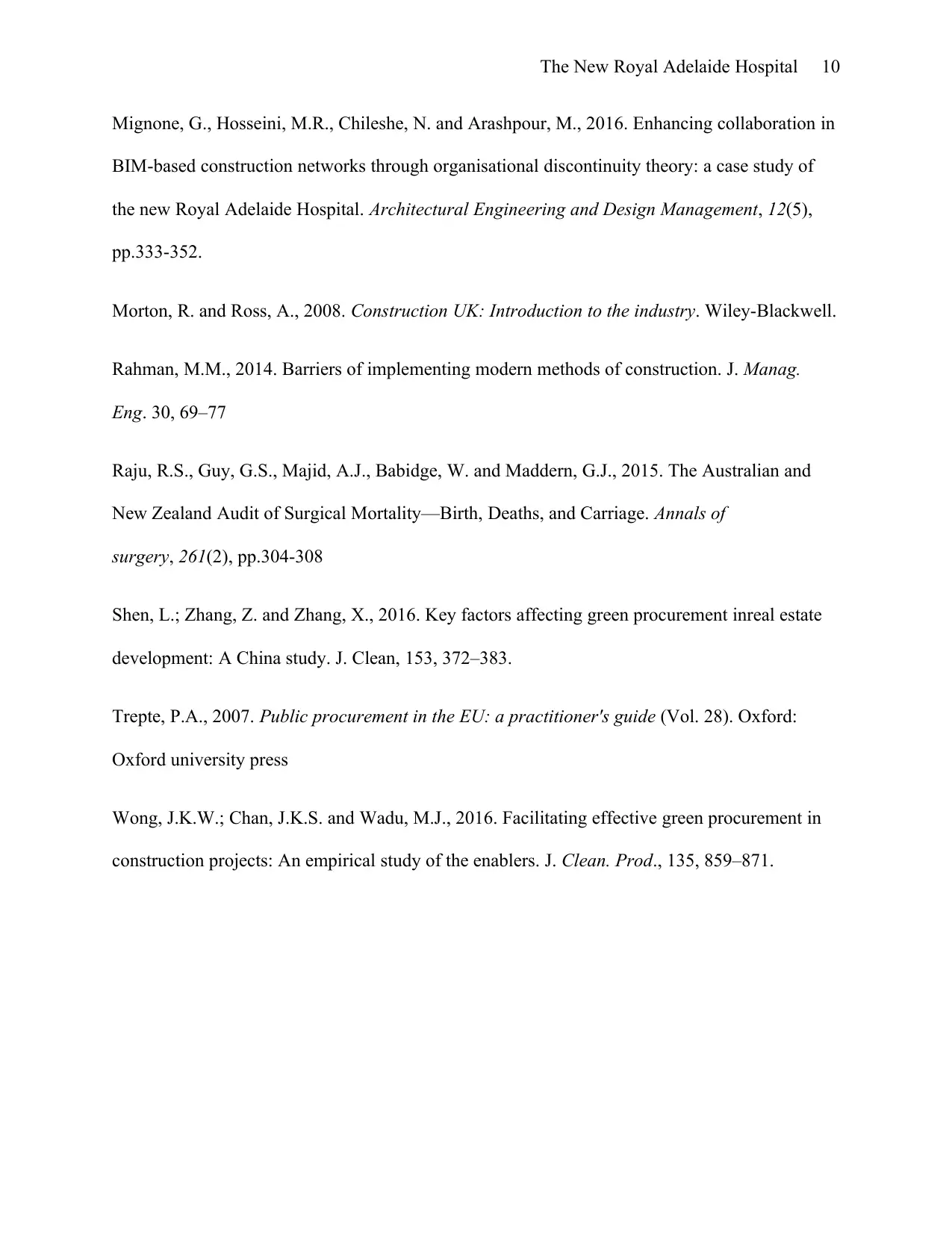
The New Royal Adelaide Hospital 10
Mignone, G., Hosseini, M.R., Chileshe, N. and Arashpour, M., 2016. Enhancing collaboration in
BIM-based construction networks through organisational discontinuity theory: a case study of
the new Royal Adelaide Hospital. Architectural Engineering and Design Management, 12(5),
pp.333-352.
Morton, R. and Ross, A., 2008. Construction UK: Introduction to the industry. Wiley-Blackwell.
Rahman, M.M., 2014. Barriers of implementing modern methods of construction. J. Manag.
Eng. 30, 69–77
Raju, R.S., Guy, G.S., Majid, A.J., Babidge, W. and Maddern, G.J., 2015. The Australian and
New Zealand Audit of Surgical Mortality—Birth, Deaths, and Carriage. Annals of
surgery, 261(2), pp.304-308
Shen, L.; Zhang, Z. and Zhang, X., 2016. Key factors affecting green procurement inreal estate
development: A China study. J. Clean, 153, 372–383.
Trepte, P.A., 2007. Public procurement in the EU: a practitioner's guide (Vol. 28). Oxford:
Oxford university press
Wong, J.K.W.; Chan, J.K.S. and Wadu, M.J., 2016. Facilitating effective green procurement in
construction projects: An empirical study of the enablers. J. Clean. Prod., 135, 859–871.
Mignone, G., Hosseini, M.R., Chileshe, N. and Arashpour, M., 2016. Enhancing collaboration in
BIM-based construction networks through organisational discontinuity theory: a case study of
the new Royal Adelaide Hospital. Architectural Engineering and Design Management, 12(5),
pp.333-352.
Morton, R. and Ross, A., 2008. Construction UK: Introduction to the industry. Wiley-Blackwell.
Rahman, M.M., 2014. Barriers of implementing modern methods of construction. J. Manag.
Eng. 30, 69–77
Raju, R.S., Guy, G.S., Majid, A.J., Babidge, W. and Maddern, G.J., 2015. The Australian and
New Zealand Audit of Surgical Mortality—Birth, Deaths, and Carriage. Annals of
surgery, 261(2), pp.304-308
Shen, L.; Zhang, Z. and Zhang, X., 2016. Key factors affecting green procurement inreal estate
development: A China study. J. Clean, 153, 372–383.
Trepte, P.A., 2007. Public procurement in the EU: a practitioner's guide (Vol. 28). Oxford:
Oxford university press
Wong, J.K.W.; Chan, J.K.S. and Wadu, M.J., 2016. Facilitating effective green procurement in
construction projects: An empirical study of the enablers. J. Clean. Prod., 135, 859–871.
Paraphrase This Document
Need a fresh take? Get an instant paraphrase of this document with our AI Paraphraser

The New Royal Adelaide Hospital 11
1 out of 11
Related Documents
Your All-in-One AI-Powered Toolkit for Academic Success.
+13062052269
info@desklib.com
Available 24*7 on WhatsApp / Email
![[object Object]](/_next/static/media/star-bottom.7253800d.svg)
Unlock your academic potential
Copyright © 2020–2025 A2Z Services. All Rights Reserved. Developed and managed by ZUCOL.





